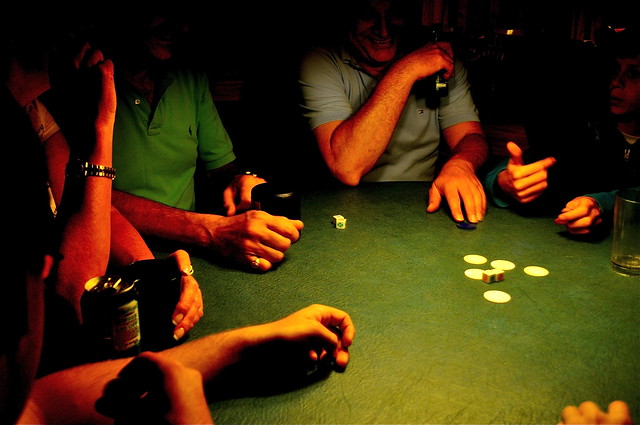
I had the good fortune of playing Divinare last weekend. ("Fortune." Get it?) It's about old-timey psychics competing to prove who's the real deal. It's a clever little deduction game with an element of take-that and push-your-luck in one elegant package. As much as I love Cards-with-Numbers, I'm especially fascinated with cards that only feature art and no other game information. I'll do a post on that soon.
Check out Tom Vasel's review of Divinare for details of how to play. The experience reminds me a lot of playing the classic game Liar's Dice. If you haven't played that, you should too. Here are the basic rules as I play them at home. Note that there are numerous variants, I just happen to like this one.
Each player has five standard dice and dice cups for concealment.So, a fairly simple game of bluffing and deduction, with lots of on-the-spot permutations. One nice thing Divinare provides is four boards that visually show the likelihood of each suit in the deck, thus making it fairly obvious how rare it is. There are probability charts for Liar's Dice, like the spreadsheet here, but you don't get that tight sense of area-control like you do in Divinare. I see two options for hacking.
Each round, each player rolls their dice under their cups. Each player looks at their results in secret. The first player guesses out loud a quantity and a face. This is called a "bid." The quantity is how many of the chosen face have been rolled in total on the table.
For example, "Five threes," means "I think there are at least five threes on the table."
Then the next player has three choices:
- Raise: Increase the quantity. For example, "I think there are at least six threes on the table."
- Challenge: You think the current bid is wrong. All players then reveal their dice. If the bid is correct, you lose one of your dice. If the bid is wrong, the bidder loses one of her dice.
- Approve: You think the current bid is exactly correct. If the bid is correct, all other players lose a die. If the bid is wrong, you lose a die.
When you run out of dice, you're out of the game. The last player with dice remaining wins.
Area Control Boards
There is a board showing a grid of numbers and ranges. Columns represent faces, the rows represent quantities. Each player has two meeples that begin on the 0,0 corner. Instead of a bid, you have to reveal one of the dice in your hand. Upon doing so, you move your meeples along either axis of the board, landing on either a column or a row. Play continues until all dice are revealed. You can always move a meeple back to the 0,0 corner or to another space, but you cannot occupy a space with another player's meeple. In the end, players are awarded points for accuracy of their placement on the board. Correct column? x points. Correct row? y points. Exact correct? z points.
Colored Dice
This option is the same as the above, with an additional layer of deduction. Each player has nine dice: Two blue, three white, four red. When you reveal your die, you can only move the meeples on the board matching the color of that die. So, you only get two guesses on the blue board, three guesses on the white, four on the red. Blue: Triple points, White: Double points, Red: Normal points.
How about you? Any deduction games you particularly enjoy? Share your thoughts in the comments!
No comments:
Post a Comment